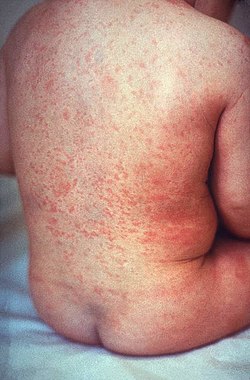Exanthem

Editor-In-Chief: Prab R Tumpati, MD
Obesity, Sleep & Internal medicine
Founder, WikiMD Wellnesspedia &
W8MD medical weight loss NYC and sleep center NYC
| Exanthem | |
|---|---|

| |
| Synonyms | N/A |
| Pronounce | N/A |
| Specialty | N/A |
| Symptoms | Rash, fever, malaise, headache |
| Complications | Secondary infection, scarring |
| Onset | Sudden |
| Duration | Varies depending on cause |
| Types | N/A |
| Causes | Viral infection, bacterial infection, drug reaction |
| Risks | Immunocompromised, young children, unvaccinated individuals |
| Diagnosis | Clinical diagnosis, skin biopsy, blood test |
| Differential diagnosis | Measles, rubella, roseola, scarlet fever, Kawasaki disease |
| Prevention | Vaccination, hygiene |
| Treatment | Symptomatic treatment, antihistamines, antipyretics |
| Medication | N/A |
| Prognosis | Generally good with treatment |
| Frequency | Common in children |
| Deaths | N/A |
Exanthem[edit]
Introduction[edit]

Exanthem refers to a widespread, acute rash that appears on the skin. It is commonly associated with viral infections, allergies, or as a reaction to medications. Exanthems are especially prevalent in children and can be a key indicator of certain diseases.
Causes[edit]
Exanthem can be triggered by various factors:
- Viral Infections: Such as measles, rubella, and chickenpox.
- Bacterial Infections: Including scarlet fever and certain forms of meningitis.
- Drug Reactions: Some medications can cause allergic skin reactions.
- Autoimmune Disorders: Conditions like lupus may present with exanthematic rashes.
Types of Exanthem[edit]
Exanthem is categorized into several types, each with distinct characteristics:
- Exanthem Subitum (Roseola Infantum): Characterized by high fever and a rash that appears as the fever subsides.
- Rubella (German Measles): Features fine, pink rashes.
- Measles (Rubeola): Known for its large, flat blotches that flow into one another.
- Erythema Infectiosum (Fifth Disease): Causes a “slapped cheek” appearance in children.
- Hand, Foot, and Mouth Disease: Presents with sores in the mouth and a rash on the hands and feet.
Diagnosis[edit]
Diagnosing exanthem involves:
- Clinical Examination: Assessing the type, location, and pattern of the rash.
- Medical History: Reviewing symptoms and exposure to potential triggers.
- Laboratory Tests: Blood tests, throat swabs, or skin biopsies, if necessary.
Treatment[edit]
Treatment of exanthem varies based on the underlying cause:
- Viral Exanthems: Generally require no treatment, as they resolve on their own.
- Bacterial Infections: Treated with antibiotics.
- Allergic Reactions: Managed with antihistamines or steroids.
- Supportive Care: Includes hydration and fever management.
Prevention[edit]
Preventive measures include:
- Vaccinations: Against diseases like measles and rubella.
- Good Hygiene Practices: To reduce the risk of infection.
- Avoiding Known Allergens: If allergic reactions are the cause.
See Also[edit]
References[edit]
<references/>
External Links[edit]
Ad. Transform your life with W8MD's Budget GLP-1 injections from $75


W8MD offers a medical weight loss program to lose weight in Philadelphia. Our physician-supervised medical weight loss provides:
- Weight loss injections in NYC (generic and brand names):
- Zepbound / Mounjaro, Wegovy / Ozempic, Saxenda
- Most insurances accepted or discounted self-pay rates. We will obtain insurance prior authorizations if needed.
- Generic GLP1 weight loss injections from $75 for the starting dose.
- Also offer prescription weight loss medications including Phentermine, Qsymia, Diethylpropion, Contrave etc.
NYC weight loss doctor appointmentsNYC weight loss doctor appointments
Start your NYC weight loss journey today at our NYC medical weight loss and Philadelphia medical weight loss clinics.
- Call 718-946-5500 to lose weight in NYC or for medical weight loss in Philadelphia 215-676-2334.
- Tags:NYC medical weight loss, Philadelphia lose weight Zepbound NYC, Budget GLP1 weight loss injections, Wegovy Philadelphia, Wegovy NYC, Philadelphia medical weight loss, Brookly weight loss and Wegovy NYC
|
WikiMD's Wellness Encyclopedia |
| Let Food Be Thy Medicine Medicine Thy Food - Hippocrates |
Medical Disclaimer: WikiMD is not a substitute for professional medical advice. The information on WikiMD is provided as an information resource only, may be incorrect, outdated or misleading, and is not to be used or relied on for any diagnostic or treatment purposes. Please consult your health care provider before making any healthcare decisions or for guidance about a specific medical condition. WikiMD expressly disclaims responsibility, and shall have no liability, for any damages, loss, injury, or liability whatsoever suffered as a result of your reliance on the information contained in this site. By visiting this site you agree to the foregoing terms and conditions, which may from time to time be changed or supplemented by WikiMD. If you do not agree to the foregoing terms and conditions, you should not enter or use this site. See full disclaimer.
Credits:Most images are courtesy of Wikimedia commons, and templates, categories Wikipedia, licensed under CC BY SA or similar.
Translate this page: - East Asian
中文,
日本,
한국어,
South Asian
हिन्दी,
தமிழ்,
తెలుగు,
Urdu,
ಕನ್ನಡ,
Southeast Asian
Indonesian,
Vietnamese,
Thai,
မြန်မာဘာသာ,
বাংলা
European
español,
Deutsch,
français,
Greek,
português do Brasil,
polski,
română,
русский,
Nederlands,
norsk,
svenska,
suomi,
Italian
Middle Eastern & African
عربى,
Turkish,
Persian,
Hebrew,
Afrikaans,
isiZulu,
Kiswahili,
Other
Bulgarian,
Hungarian,
Czech,
Swedish,
മലയാളം,
मराठी,
ਪੰਜਾਬੀ,
ગુજરાતી,
Portuguese,
Ukrainian


